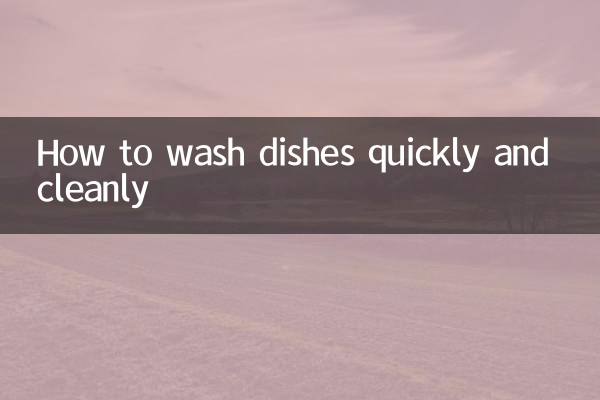Title: How to wash dishes quickly and cleanly
Washing dishes is an unavoidable chore in daily life, but how to complete this task efficiently and cleanly is a science. Combining the hot topics and hot content on the Internet in the past 10 days, we have compiled a set of scientific dishwashing methods to help you save time and improve cleaning results.
1. Preparation before washing dishes

Doing the prep work before you start doing the dishes can go a long way. Here are the recommended steps:
| step | Operating Instructions |
|---|---|
| 1. Classify tableware | Classify tableware according to material (glass, ceramic, stainless steel, etc.) and degree of oil stain to avoid cross-contamination. |
| 2. Pretreatment of oil stains | Use paper towels or kitchen scrapers to remove food residue from tableware to reduce the difficulty of subsequent cleaning. |
| 3. Prepare tools | Prepare dishwashing sponges, dishwashing liquid, hot water, and a drain rack to avoid scrambling in the middle. |
2. Steps and techniques for washing dishes
Scientific dishwashing order and techniques can significantly improve efficiency. The following are the specific operations:
| step | Operating Instructions |
|---|---|
| 1. Soak | Soak heavily oily tableware in hot water for 5-10 minutes to soften the oil stains. |
| 2. Clean from light to heavy | Wash less greasy tableware first (such as cups), then wash heavily greasy dishes (such as woks). |
| 3. Use appropriate amount of dish soap | Too much dish soap will make rinsing difficult. It is recommended to dilute it in a ratio of 1:10. |
| 4. Consider both internal and external aspects | When cleaning dishes, be sure to scrub them both inside and out, especially cups and deep-mouthed containers. |
3. Recommended practical tools for efficient dishwashing
If a worker wants to do his job well, he must first sharpen his tools. The following are recommended dishwashing tools that are popular on the Internet:
| Tool name | Features |
|---|---|
| 1. Silicone dish brush | Does not damage the surface of tableware, is easy to clean and durable. |
| 2. Replaceable head sponge | Environmentally friendly and economical, the sponge head can be replaced individually. |
| 3. Special balls for dishwashers | Suitable for dishwasher users to improve cleaning performance. |
| 4. Draining rack | Double-layer design saves countertop space. |
4. Finishing work after washing dishes
The finishing touches after washing the dishes are equally important. Here are some things to pay attention to:
| step | Operating Instructions |
|---|---|
| 1. Rinse | Rinse the dishes thoroughly with running water to avoid detergent residue. |
| 2. Drain | Invert the dish onto a draining rack to ensure that the water evaporates completely. |
| 3. Cleaning tools | Clean sponges and brushes promptly to avoid bacterial growth. |
| 4. Regular disinfection | Disinfect dishes once a week with boiling water or disinfectant. |
5. Frequently Asked Questions
The following are dishwashing-related questions and answers that netizens have recently paid attention to:
| question | answer |
|---|---|
| 1. Is the dishwasher really cleaner than hand washing? | Dishwasher cleans through high-temperature and high-pressure water flow, which is more thorough, but requires regular maintenance. |
| 2. How to remove stubborn stains from tableware? | Soak with baking soda or white vinegar, then wipe with a soft cloth. |
| 3. How often should the dishwashing sponge be replaced? | It is recommended to replace it every 1-2 weeks, or immediately if you notice any odor. |
Summarize
Washing dishes may seem simple, but mastering scientific methods and tools can greatly improve efficiency. By sorting, pre-processing, using tools wisely and paying attention to the finishing touches, you can easily achieve this“Quick and clean”dishwashing goals!

check the details

check the details